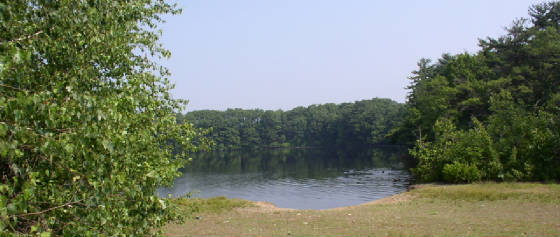|
|
 |
|

The State's plan to treat Lake Cochituate with poisons threatens our health and environment.
• Natick's drinking water comes primarily from wells supplied through the Lake Cochituate area aquifer.
• State officials planned to put poisons in Lake Cochituate to control the invasive milfoil plant. The State plan was
stopped when local citizens appealed and presented the health threats.
• The State pulled out of the process and is now asking Natick’s Conservation Commission to approve a new plan,
which will again primarily rely on toxic chemicals to control the milfoil.
• The State admits that its approach is only short term and will need herbicides reapplied on a regular basis.
• These chemical herbicides are registered poisons. It is against the law to claim they are "safe"; or "EPA-approved",
even when "used as directed." *, **
• Concerned citizens are determined to replace the misguided toxic plans with a comprehensive plan which ensures the
health and safety of our tap water and Lake.
• There are safer alternatives such as harvesting, pulling, matting, suctioning, draw downs, biological controls, and
more, which do not pose the risks of treating the lake water with poisons.
• "In many situations, there may be non-chemical methods to control pests. EPA recommends considering and using these
methods as part of an overall pest management strategy, often called Integrated Pest Management."***
• In one study, it was shown that the use of chemicals was found to be more than two times as expensive as natural weed
control over a five year period.***
Please find out more about this issue.
For more info: Protect Our Water Resources
On the web at LakeCPOWR.tripod.com
(508) 653-8228
* U.S. EPA Website http://www.epa.gov/oppfead1/labeling/lrm/chap-12.htm
** 333 CMR 13.03 Massachusetts Pesticide Regulations
*** U.S. EPA Website http://www.epa.gov/pesticides/health/reducing.htm
**** U.S. EPA Lake and Reservoir Restoration Guidance Manual (EPA-440-90-006)
|
 |
|
Lake Cochituate
Natick's Valued Water Resource
CHRONOLOGY OF EVENTS
* In 2002, a non-native invasive species of weed called Milfoil was discovered in Lake Cochituate by the Department of Environmental
Management. The DEM hired Aquatic Control Technology, Inc. (ACT) to develop a Lake Management Plan.
* In 2003, the Department of Conservation and Recreation (DCR) requested permission from the Natick Conservation Commission
(NCC) to apply the herbicides diquat and endothall in Lake Cochituate based on the plan developed by ACT. The NCC issued
conditional approval for the herbicides to be used on Lake Cochituate.
* Local concerned citizens of Natick appealed to the MA Department of Environmental Protection, DEP. The Town of Natick
drinking water supply is drawn at a rate of over 1 million gallons per day from the Springvale wells located in Natick on
the South Pond and the Evergreen wells located on the Middle Pond of Lake Cochituate. It is uncertain what effect the use
of the herbicides, diquat and endothall, would have on the children and families of Natick.
* The DEP decision favored the plan to apply herbicides.
* In 2004, a second appeal was filed to the DEP for a hearing with the Division of Administrative Law Appeals.
* A hearing date was set for June 2005. However, after concerned citizens presented expert testimony regarding the risks
of the stateís plan, the DCR withdrew from the appeal. The DCR announces that it will start the process over with a new Notice
of Intent to be submitted to the Natick Conservation Commission for the use of a different herbicide, Sonar (fluridone).
* While under appeal, the Department of Conservation and Recreation, DCR, can not apply herbicides. But the DCR can use
alternate and effective methods for controlling the spread of milfoil in the lake by other methods of weed control that are
immediately available. The DCR Plan recommends these methods only for the North and Middle Ponds. There is no alternative
plan for the South Pond where the greatest density of milfoil exists.
* Milfoil is a non-native and invasive species of aquatic weed that grows primarily along the shallow lake edges. There
is currently no known method to completely eradicate milfoil weed. There are, however, several methods available to control
the spread of milfoil. Hand weeding, suction and mechanical harvesting, benthic barriers, draw down techniques are natural
alternatives to herbicides. Additionally, preventative practices of placing nets in the lake and boater awareness can help
to prevent the fragmentation and propagation of milfoil.
|
 |
|
|
 |
|
|
 |
|
|
|
|
You can contact us at lakecpowr@yahoo.com
Please excuse the advertising which you'll find sprinkled about our site. POWR does not have any control over the ads which
are generated by Tripod. Without them, free web sites like this one, would not likely be available.
|
|
|
 |

